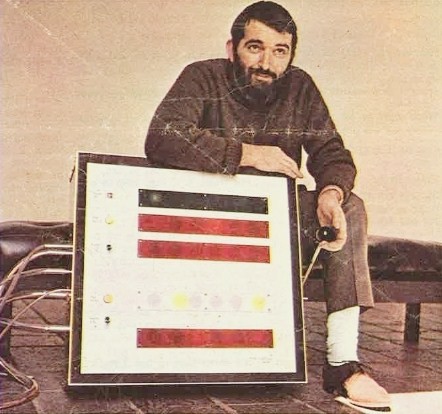
Growing up in Australia in the 1960s, "Mini-Computer" by Ken Reinhard was my first encounter with Computers and Art.

Who can tell…
ART? SCULPTURE? MACHINERY?
What would you expect to see at on art exhibition featuring on "environ machine" and a "mini-computer"? Something resembling office furniture?
That's what I thought, until I opened my program (or a new exhibition at the Bonython Art Gallery in Sydney. The notes said "the environ machine projects images on a wall, puffs perfume, and makes gay noises." It sounded like something from a laboratory!
I think of art as paintings and sculptures. I wasn't prepared for a gallery full of space-age machines pulling like engines and looking like parts of a James Bond film set. The "environ machine" turned out to be a 12-foot tall box-like object, transparent at top and bottom with tubing and arrows inside it.
The designer, Ken Reinhard, came up to show how it worked. He pulled a lever, pressed a button and presto! Perfume wafted from one side of the box, nude figures bounced across the opposite wall, and sounds like a player piano rose from the bottom.
"Wow! Whatever would you do with this?" I asked.
"It would make a good Christmas present," said Ken. "It conk three months to make. After all, you can have a choice of two perfumes."
I made a mental note of any of my friends who might like a 12ft tall Christmas present.
Ken's mini-skirted blonde wife, Barbara, took me aside and whispered. "There is precious little of our house fit to live in. But we CAN get in the front door and the kitchen now.
"I'm so glad the exhibition is at the gallery and not at home. We haven't been able to do anything at home while we've been building this machine. It has been chaotic!"
Their two children, Malcolm, seven, and Arianne, five, were examining the mini-computer at the end of the room.
lt was about three feet tall, looked like a pin-ball machine and had lights flashing on and off in three different colours. "I like this one," said Malcolm.
"He has had lots of fun discussing it at school," said Barbara. "I'm sure his friends will come to the exhibition to see it."
Meanwhile, Arianne was getting very involved with a large computer at the back of the gallery.
"I thought the computer was a pretty marvellous piece of sculpture?" said Ken.
"I looked at one through a shop window, but I wasn't over-influenced by the real thing."
"This took three months to build. The inside was awful. I would say it was aesthetic, not practical." (Privately, I agreed with him.) We heard a buzzing sound like a car horn. It was Malcolm and Arianne pulling the handle on a piece of machinery with a blown-up picture of a truck behind it. From its site it looked as it it should have been on the road. and the yellow and black lines at the bottom stop(' out like traffic markings.
"What is it?" I asked.
"Just what it looks like," said Ken. "I like road blocks, bright colours and pieces of machinery. There aren't any hidden symbolic meanings here."
We took a last look at the machine which puffed perfume. "It would look good in your living-room," said Ken.
Well, it might be okay in YOUR living-room– if you can afford $4 a week for French perfume just to feed a machine!
— JUDY MacGREGOR-SMITH
Source: [Australian] Woman's Day, October 14, 1968.

"707A" (Micro-Mini Comp.) 30" X 30" plus – Kinetic – 1970.
1972 Sweeney Reed Gallery Catalogue (pdf).
